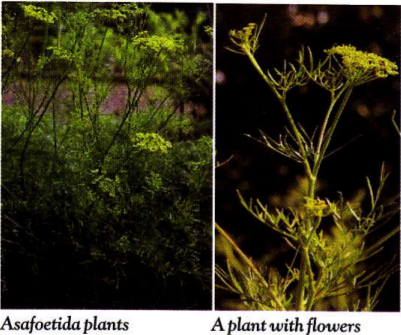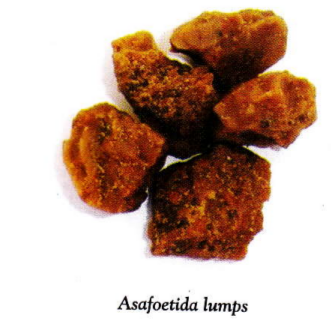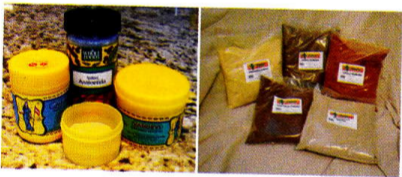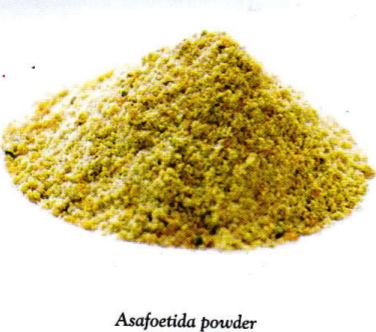Asafoetida
Asafoetida is the dried aromatic gum-resin exuded from the living rhizome, rootstock or taproot of varied plant species of genus Ferula.
Local names: Hing, Asafetida, Ingo, Inguva
Plant Sources: Ferula asafoetida and allied species (Ferula foetida and Ferula narthex).
Family: Umbelliferae
Distribution: The perennial asafoetida plants has several varieties and are native to the region between the Mediterranean region to Central Asia, especially Iran and Afghanistan. The other species, known botanically as Ferula northex, grow abundantly in Kashmir, Western Tibet and Afghanistan.
Major producing countries: Afghanistan, Iran, Turkistan. Ferula gum-resins are imported to India, mainly from Iran and Afghanistan. A part of the imported gum resin is re-exported to various countries after some processing and value addition.
Harvesting/Collection of Gum-Resin
Method of harvesting/tapping: The gum resin is obtained from incisions in the roots and rhizomes of the plants. Usually plants of sour to five years old develop very thick and fleshy, carrot shaped roots. The upper part of the root is laid bare and the stem is cut close to the crown. The exposed surface is covered by a dome shaped structure made of twigs and earth. A milky juice exudes from the cut surface which soon coagulates when exposed to air. After some days, the exudate gum-resin is scraped off and a fresh slice of the root is cut.
The upper part of the root is laid bare and the stem is cut close to the crown. The exposed surface is covered by a dome shaped structure made of twigs and earth. A milky juice exudes from the cut surface which soon coagulates when exposed to air. After some days, the exudate gum-resin is scraped off and a fresh slice of the root is cut.
Period of harvesting/collection: Tapping is usually done in March and April, just before the plants flower.
Processing and Value Addition
The milk juice obtained from the root becomes a brown, resin-like mass after drying. Asafoetida is processed and marketed either as lumps or in powdered form. The lump asafoetida is the most common form of pure asafoetida.The trading form is either the pure resin or so-called “compounded asafoetida" which is a fine powder consisting to more than 50% of rice flour and gum arabic to prevent lumping. The advantage of the compounded sorin is that is is easier to dose.
The gum-resin is also steam distilled to obtain the essential oil known as Oil of Asafoetida.
Properties
- Asafoetida has a powerful odour and a bitter acrid taste, due to the presence of sulphur compounds in it.
- Asafoetida contains about 40-60 per cent of resin
 , 25 percent of gum, 10 percent of volatile essential oil and other compounds like ash.The resin consists chiefly of asaresinotennol, free or combined with ferulic acid.
, 25 percent of gum, 10 percent of volatile essential oil and other compounds like ash.The resin consists chiefly of asaresinotennol, free or combined with ferulic acid. - An analysis of asafoetida shows it to consist of carbohydrates 67.8 per cent per 100 gms, moisture 16.0 percent, protein 4.0 per cent, fat 1.1 percent, minerals 7.0 percent and fibre 4.1 percent. Its mineral and vitamin contents include substantial calcium besides phosphorus, iron, carotene, riboflavin and niacin.
Uses
- Asafoetida has long been used as a food flavouring and medicinal herb. It is still sometimes used in modern herbalist where it is especially valued in the treatment of hysteria, some nervous conditions, bronchitis, asthma and whooping cough.
- The gum resin is antispasmodic, carminative, expectorant, laxative, sedative. The volatile oil in the gum is eliminated through the lungs, making this an excellent treatment for asthma.
- It is used as a flavoring agent and forms a constituent of many spice mixtures.
- Asafoetida is useful in the treatment of respiratory disorders like whooping cough, asthma and bronchitis.
- It is reputed as a drug which expels wind from the stomach and counteracts any spasmodic disorders. It is also a nervine stimulant, digestive agent and a sedative.


ಕೊನೆಯ ಮಾರ್ಪಾಟು : 3/1/2020
Dammar designates a group of resins obtained from ...
This topic provides information about Guggul or In...
This topic provides information about Gum karaya, ...
This topic provides information related to cultiva...
